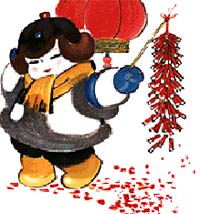The Chinese Calendar - A Short Introduction
![]()
|
The Chinese lunar calendar is the longest chronological record in history, dating from 2,600 BC, when the Emperor Huang Di introduced the first cycle of the zodiac. (Some accounts claimed that it was the Emperor Yao.) The Chinese Calendar is lunisolar with 7 intercalary months in a 19-year cycle. The Chinese New Year begins somewhere between late January and middle of February. Unlike the Hebrew calendar, where the leap years can be calculated very simply and the intercalary month always appears in the same time of the year, the Chinese leap year and month are computed based on astronomical observations and rather complex calculations. One of the better known aspects of the Chinese calendar are the astrological animals. The traditional Chinese calendar counts years based on a 60-year cycle. Each year is given a name based on two characters. The first is made up of one of 10 characters known as 'earthly branches' and the second is made up of one of 12 characters known as 'heavenly stems'. The 60-year cycle is derived by naming the years using those two sets of characters in sequence. Each of the 12 'heavenly stems' is also associated with an animal, thereby assigning an animal to a year. The following table shows the animals and their associated years from 1924 to 2007.
|
